 Little Red Riding Hood (1922) is one of of only six "Laugh-O-Gram Fairy Tale" cartoons which Walt Disney & Ub Iwerks created in Kansas City.
Little Red Riding Hood (1922) is one of of only six "Laugh-O-Gram Fairy Tale" cartoons which Walt Disney & Ub Iwerks created in Kansas City.
These precursors to the Alice Comedies (a few of which were also called Laugh-o-Grams) were well received by the public, but Walt's distributor failed to pay him, & his little company was forced into bankruptcy.
As the story opens, Mom is making doughnuts with her cat. She tosses a wad of dough into the air, the cat shoots a hole through the wad with a rifle, & the dough falls into a pot on the stove to cook into a finished doughnut.
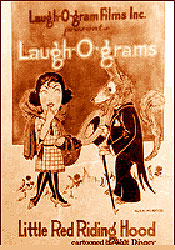 The cat is delighted by the process, & the portrait of grampa on the wall laughs & laughs. The cat is delighted by the process, & the portrait of grampa on the wall laughs & laughs.
Red is given a a basket of doughnuts to take to grandma's house & off she goes in her dog-pushed auto.
When she gets a flat, she blows up one of the doughnuts to replace her ruined tire. Along the way she meets a horndog of a man driving a flivver, probably a child molester, though perhaps he just wanted those doughnuts.
He drives ahead & finding Grandma has gone to the market, he enters the house & lies in wait for Red. When she goes inside the house, the house begins bouncing & shaking, leaving us to imagine Red is being assaulted.
Red's dog runs off to find a guy with an airplane & they fly back to save the day. Very primitively drawn, but prety cool for 1922.
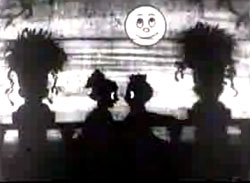 Another "Laugh-O-Gram" cartoon features Julius the Cat (probably not yet named however) as the one & only friend of Cinderella (1922).
Another "Laugh-O-Gram" cartoon features Julius the Cat (probably not yet named however) as the one & only friend of Cinderella (1922).
Cindy & the cat are doing the dishes, of which there are a great many, while the two lazy & homely step-sisters laze about eating snacks.
The Prince is a bit of a hick hunter who is out hunting Pete the Bear (also perhaps not yet named). HIs clan has a big hillbilly band up in the bear cave. The prince pretty much catches the whole lot of them, which seems unfortunate.
 There's a big ball for the prince at the king's palace "on Tuesay, Friday the 13th." Just everyone is invited, the prince's dog delivering the invites on his paper route. There's a big ball for the prince at the king's palace "on Tuesay, Friday the 13th." Just everyone is invited, the prince's dog delivering the invites on his paper route.
The ugly stepsisters are off to the ball leaving Cindy behind, until the fairy godmother pops in & turns the cat into a black-face chaufeur of a vintage auto, with Cinderella in a print dress that'll turn to rags at midnight.
Everybody's doing the cake-walk at the ball when Cinderella shows up & the prince falls right in love. The king materializes inexplicably & everyone dances the cake-walk again. Even the cat finds a partner, a friendly dog. Cindy & the prince go outside under the moonlight & spoon.
At midnight Cinderella runs home, losing a clodhopper shoe. Next morning the prince in his hunting cap & with his dog track the lost beloved, but it turns out they were tracking a duck, though he soon finds her in the nearby park.
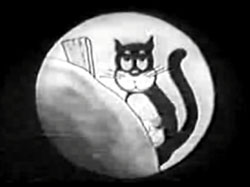 A Laugh-O-Gram The Four Musicians of Bremen (1922) is another modernized version of an old fairy tale, though by now a Roaring Twenties update is itself a century past.
A Laugh-O-Gram The Four Musicians of Bremen (1922) is another modernized version of an old fairy tale, though by now a Roaring Twenties update is itself a century past.
The quartet, less talented than they believe themselves to be, consist of a donkey in a straw hat who plays the sax, a rooster who plays the lute, a dog who plays the violin, & a cat. Chased out of every town for trying to perform, they sit down by a riverbank, & the donkey weeps copious tears.
They begin to perform their music by the river & they're good enough that all the fish start dancing on the riverbottom, & the frogs are cutting a muddy rug. The cat is waiting with a board to wack at fish as they leap from the river for joy of the music, as the unemployed musicians are all starving.
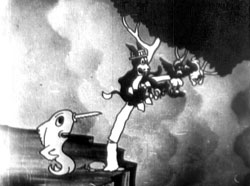 One fish can't resist coming out on land to dance to the tune, but it leaps & dances much too swiftly to be smacked by a board. One fish can't resist coming out on land to dance to the tune, but it leaps & dances much too swiftly to be smacked by a board.
Totally frustrated the cat pursues the fish into its own domain, where a big swordfish turns the tables on the cat.
The swordfish pursues the band members overland. They have a number of scrapes & escapes, then an army shows up most inexplicably & begins to bombard a house with canonballs because the band has taken refuge therein.
The cat takes an amazing ride on a flying canonball that seems like it will never stop zipping through the air. Shaping his tail into a paddle, he stears the canonball against the army & wins the day. His three mates spread out a blanket to catch him as he falls from the sky, & they live happily ever after.
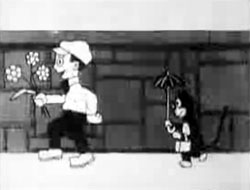 The Laugh-O-Gram Puss In Boots (1922) opens with Puss walking along with a tiny umbrella & a purse. He's strolling behind a boy who has picked flowers for his girl.
The Laugh-O-Gram Puss In Boots (1922) opens with Puss walking along with a tiny umbrella & a purse. He's strolling behind a boy who has picked flowers for his girl.
As the girl & boy spoon, Puss goes to visit the chauffeur James, who is a dog in driver's cap trying to start the car with a crank. When Puss shows up, they play games & then start spooning.
Meanwhile the king sees his daughter being courted by the peasant lad, & chases after him angrily, then brutally tosses him out of the royal gardens. Puss is soon captured & tossed out as well.
The dispirited lad strolls down the street & lingers outside of a booterie. Puss asks him to buy her a pair of boots, but the kid says nothin' doing, & instead they go to the cinema to see Rodolph Vaselino in 'Throwing the Bull,' accompanied by a live orchestra.
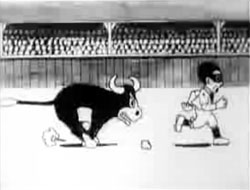 As a silent film, dialogue is placed inside comic strip balloons. The re-release had a music soundtrack & a few sound effects added. As a silent film, dialogue is placed inside comic strip balloons. The re-release had a music soundtrack & a few sound effects added.
The Rudolf Vaselino film gave Puss an idea how to win over the king, but she won't tell the lad unless he'll buy her a pair of "flapper boots."
In her new boots, Puss goes about town putting up posters for the Masked Matadore who will conquer a bull. The bull fight is well-attended by everyone in town, including the king & his daughter. Even the king's driver James gets to sit in the King's Box to watch the event.
The kid in a mask is eager to prove his heroism, but when a crazed bull is set loose in the arena, he turns tail & runs for his life. But then seeing the princess, he turns around to confront the bull, winning not only the battle with the bull, but gaining the king's permission to marry the princess.
copyright © by Paghat the Ratgirl
|
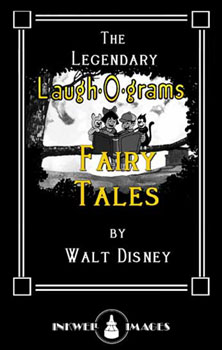

 The cat is delighted by the process, & the portrait of grampa on the wall laughs & laughs.
The cat is delighted by the process, & the portrait of grampa on the wall laughs & laughs.
 There's a big ball for the prince at the king's palace "on Tuesay, Friday the 13th." Just everyone is invited, the prince's dog delivering the invites on his paper route.
There's a big ball for the prince at the king's palace "on Tuesay, Friday the 13th." Just everyone is invited, the prince's dog delivering the invites on his paper route.
 One fish can't resist coming out on land to dance to the tune, but it leaps & dances much too swiftly to be smacked by a board.
One fish can't resist coming out on land to dance to the tune, but it leaps & dances much too swiftly to be smacked by a board. The Laugh-O-Gram Puss In Boots (1922) opens with Puss walking along with a tiny umbrella & a purse. He's strolling behind a boy who has picked flowers for his girl.
The Laugh-O-Gram Puss In Boots (1922) opens with Puss walking along with a tiny umbrella & a purse. He's strolling behind a boy who has picked flowers for his girl. As a silent film, dialogue is placed inside comic strip balloons. The re-release had a music soundtrack & a few sound effects added.
As a silent film, dialogue is placed inside comic strip balloons. The re-release had a music soundtrack & a few sound effects added.